Is a ‘Cannabis Facts’ Label in our Future?
A thoughtfully designed caution symbol and “Facts”-style label offer state regulators a universal approach to cannabis labeling. Plus, they would better serve the product-information needs of cannabis consumers.

In the retail cannabis industry, labeling and regulation go hand in hand. Within the United States, cannabis labeling regs are implemented state by state. Not surprisingly, each set of regulations is different from the next.
A universal standard for cannabis labeling would be a game changer for cannabis brand owners and dispensaries, creating a single set of rules while safeguarding consumers and providing easy-to-understand information about what’s in the package, its provenance, and how to consume it.
Think of how successful the uniform Nutrition Facts label has been for foods, or the Drug Facts label for over-the-counter pharmaceuticals.
With all this in mind, David L. Nathan, Medical Doctor (MD), collaborated with his son Eli Nathan to create a Universal Cannabis Product Symbol (UCPS) and Universal Cannabis Information Label (UCIL). Dr. Nathan is founder and board president of Doctors for Cannabis Regulation (DFCR) and a Distinguished Fellow of the American Psychiatric Association.
The proposed UCPS and UCIL are suitable for both medical and recreational cannabis packaging for products containing tetrahydrocannabinol (THC) or cannabidiol (CBD). The UCIL includes information such as product form, cannabis strain, product weight, serving or dose size, THC/CBD content, and health warnings. A quick-response code linking to online product and safety information is also part of the UCIL design.
The companion symbol, the UCPS, borrows from a familiar caution-sign design, incorporating a cannabis leaf inside a yellow triangle. The symbol can be rendered in black and white rather than black and yellow, if color printing is not possible.

“In the process of developing our labeling standards, we’ve listened to stakeholders and made changes to the UCIL and UCPS as we receive good feedback,” Dr. Nathan says. “Given the constraints of label printing, we eliminated multicolored options for the UCPS and UCIL and chose a black-and-yellow scheme for the UCPS that is easily adapted for black-and-white printing.”
A two-letter state code and the terms THC and/or CBD may be printed below the UCPS. DFCR offers the symbol at no cost to all government licensing authorities, with written permission.
In this exclusive Q&A, Dr. David Nathan answers questions from Packaging Digest about the UCIL and UCPS and his work to gain acceptance for them.
Why do we need a standard cannabis symbol or label?
Nathan: Wherever I travel, I listen closely to the regulatory priorities shared with me by various stakeholders in the cannabis space. There are divergent interests and perspectives on just about everything related to cannabis regulation, but there seems to be universal (forgive the pun) agreement on the need for proper labeling of legal cannabis products.
The hodgepodge of different state requirements has led to some terrible package designs, which fail to serve the needs of industry and the public. With the UCPS and UCIL, we hope to reduce the confusion and improve labeling standards that will become even more essential when federal legalization allows for interstate commerce in cannabis.

Are you working with state regulators to adopt these labeling guidelines? If so, how are you working with them, and what results have you achieved?
Nathan: Most of our outreach has been with key decision makers in the cannabis regulatory bodies of several states. We have heard a lot of enthusiasm, which doesn’t surprise me, given what they currently see in cannabis packaging in their states.
As with nearly everything in government, the process is a slow and deliberative one.
I also see this being an iterative process, as state regulators must work within the boundaries of the legislation that legalized cannabis in their state and defined certain packaging requirements.
How much progress have you made vis-à-vis acceptance of the UCPS and UCIL?
Nathan: The labeling standards are immediately available for adoption by state regulators, but for most of the past couple of years we’ve been focused on refining the UCPS and UCIL and beginning our outreach.
Thus far, several state regulators have expressed an interest in adapting and adopting these standards. In fact, I recently met with the cannabis commission of a western state and spoke with a state medical cannabis regulatory authority.
We’re also speaking with individuals and groups connected to US Pharmacopeia (USP), American Society for Testing and Materials (ASTM), and other standards organizations. One such group is at the University of the Sciences — formerly the Philadelphia College of Pharmacy & Science — which published a 2019 report on labeling standards that closely fits with this label design. Finally, I’m a member of ASTM’s Committee D37, which is developing labeling standards that fit well with our UCIL.
How close (or far) are we from federal regulations for cannabis packaging and labeling, in your opinion?
Nathan: Ah, that’s a great question. We obviously can’t have regulation without legalization, and legalization will no doubt be coupled with some level of federal regulation. I would hope that federal regulation will include packaging and labeling standards, but that remains to be seen.
So, underlying the question about federal regulation of packaging and labeling is the million-dollar question of when federal legalization will happen.

President Biden — who was once a fierce drug warrior — supports decriminalization but not legalization, and that may be the largest obstacle to federal legalization. However, there’s a lot of pressure on the White House from the 2:1 majority of American voters — including a majority of people in both parties — who want to see legalization now.
This is a rare example of bipartisanship among Democratic and Republican lawmakers in Congress, and it’s likely that their numbers will grow as candidates for office increasingly recognize that legalization is a winning issue. Given that we’ve seen legalization in several states just within the last few months, I think the process is picking up steam in 2021 and could come to fruition as soon as the next 12 months.
Download The Universal Cannabis Product Symbol (UCPS) fact sheet PDF here:
About the Author(s)
You May Also Like




